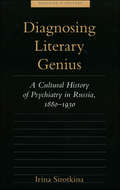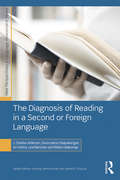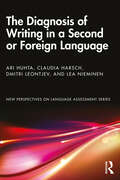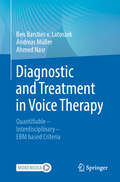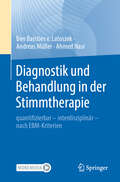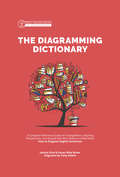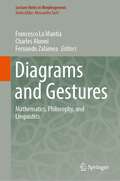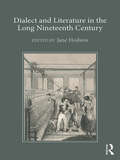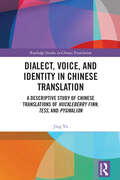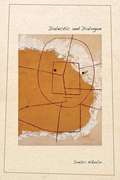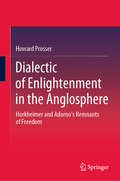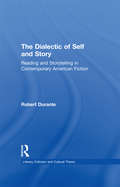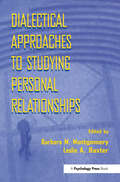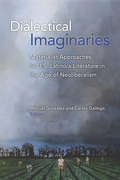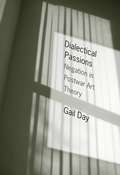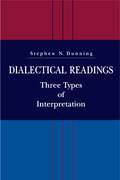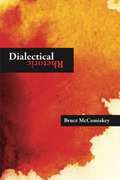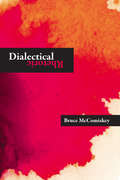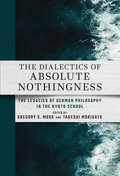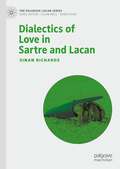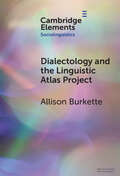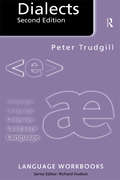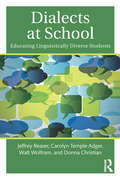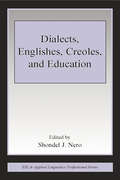- Table View
- List View
Diagnosing Literary Genius: A Cultural History of Psychiatry in Russia, 1880-1930 (Medicine and Culture)
by Irina SirotkinaWinner of the Aldo and Jeanne Scaglione Prize for Studies in Slavic Languages and Literatures from the Modern Language AssociationThe vital place of literature and the figure of the writer in Russian society and history have been extensively studied, but their role in the evolution of psychiatry is less well known. In Diagnosing Literary Genius: A Cultural History of Psychiatry in Russia, 1880-1930, Irina Sirotkina explores the transformations of Russian psychiatric practice through its relationship to literature. During this period, psychiatrists began to view literature as both an indicator of the nation's mental health and an integral part of its well-being. By aligning themselves with writers, psychiatrists argued that the aim of their science was not dissimilar to the literary project of exploring the human soul and reflecting on the psychological ailments of the age.Through the writing of pathographies (medical biographies), psychiatrists strengthened their social standing, debated political issues under the guise of literary criticism, and asserted moral as well as professional claims. By examining the psychiatric engagement with the works of Fyodor Dostoevsky, Nikolai Gogol, Leo Tolstoy, and the decadents and revolutionaries, Sirotkina provides a rich account of Russia's medical and literary history during this turbulent revolutionary period.
The Diagnosis of Reading in a Second or Foreign Language (New Perspectives on Language Assessment Series)
by J. Charles Alderson Eeva-Leena Haapakangas Ari Huhta Lea Nieminen Riikka UllakonojaThe Diagnosis of Reading in a Second or Foreign Language explores the implications of language assessment research on classroom-based assessment practices by providing an in-depth look at the little-examined field of diagnosis in second and foreign language reading. This volume examines the development of second and foreign language reading and how subsequent research findings, couched in this knowledge, can help facilitate a more-informed teaching approach in second and foreign language classrooms. By contextualizing the latest in classroom settings and presenting implications for future research in this developing area of linguistics, this book is an ideal resource for those studying and working in applied linguistics, second language acquisition, and language assessment and education. About the NPLA Series: Headed by two of its leading scholars, the series captures the burgeoning field of language assessment by offering comprehensive and state-of-the-art coverage of its contemporary questions, pressing issues, and technical advances. It is the only active series of its kind on the market, and will include volumes on basic and advanced topics in language assessment, public policy and language assessment, and the interfaces of language assessment with other disciplines in applied linguistics. Each text presents key theoretical approaches and research findings, along with concrete practical implications and suggestions for readers conducting their own research or developmental studies.
The Diagnosis of Writing in a Second or Foreign Language (New Perspectives on Language Assessment Series)
by Ari Huhta Claudia Harsch Dmitri Leontjev Lea NieminenThe Diagnosis of Writing in a Second or Foreign Language is a comprehensive survey of diagnostic assessment of second/foreign language (SFL) writing. In this innovative book, a compelling case is made for SFL writing as an individual, contextual, and multidimensional ability, combining several theoretically informed approaches upon which to base diagnosis. Using the diagnostic cycle as the overarching framework, the book starts with the planning phase, cover design, development, and delivery of diagnostic assessment, ending with feedback and feed-forward aspects to feed diagnostic information into the teaching and learning process. It covers means to diagnose both the writing processes and products, including the design and development of diagnostic tasks and rating scales, as well as automated approaches to assessment. Also included is a range of existing instruments and approaches to diagnosing SFL writing. Addressing large-scale as well as classroom contexts, this volume is useful for researchers, teachers, and educational policy-makers in language learning.
Diagnostic and Treatment in Voice Therapy: Quantifiable - Interdisciplinary - EBM based Criteria
by Andreas Müller Ben Barsties v. Latoszek Ahmed NasrThis book describes modern multidimensional-quantitative methods in voice diagnosis based on EBM evidence and proposes an evidence-based minimal standard in voice diagnosis. It provides the necessary scientific background combined with practical implementation. Current scientific findings from recent years provide speech-language pathologists, voice and speech therapists, as well as physicians in otolaryngology with new opportunities for the medical and therapeutic care of voice patients. Voice diagnostics and various voice treatments for heterogeneous voice disorders can thus be better integrated to apply structured clinical reasoning for voice treatment. Plus: Numerous videos, audios, and downloadable work materials facilitate implementation in practice.
Diagnostik und Behandlung in der Stimmtherapie: quantifizierbar - interdisziplinär - nach EBM-Kriterien
by Andreas Müller Ben Barsties v. Latoszek Ahmed NasrDieses Buch beschreibt die modernen multidimensionalen-quantitativen Verfahren in der Stimmdiagnostik, auf der Basis wissenschaftlicher Evidenz und schlägt einen evidenzbasierten Minimalstandard in der Stimmdiagnostik vor. Damit liefert es den notwendigen wissenschaftlichen Hintergrund verbunden mit der praktischen Umsetzung.Aktuelle wissenschaftliche Erkenntnisse der letzten Jahre geben Logopäd*innen, Stimm- und Sprachtherapeut*innen sowie Ärztinnen und Ärzte in der HNO und Phoniatrie neue Möglichkeiten bei der medizinischen und therapeutischen Versorgung von Patienten mit Stimmstörungen. Die Stimmdiagnostik und die unterschiedlichen Stimmbehandlungen von heterogenen Stimmstörungen können somit besser verzahnt werden, um ein Clinical Reasoning für die Stimmbehandlung strukturiert anzuwenden. Plus: Zahlreiche Videos, Audios und Arbeitsmaterialien zum Download erleichtern die Umsetzung in die Praxis.
The Diagramming Dictionary: A Complete Reference Tool For Young Writers, Aspiring Rhetoricians, And Anyone Else Who Needs To Understand How English Works (Grammar for the Well-Trained Mind #0)
by Susan Wise Bauer Jessica OttoOn its own or as a supplement to the Grammar for the Well-Trained Mind program, this complete compendium of sentence diagramming rules, complete with illustrated sample diagrams, will become an indispensable guide to diagramming and writing—throughout high school, into college, and beyond. Do you understand what makes good writing "good"? Are you struggling against your words instead of using them to express yourself well? Diagramming a sentence shows you how it is (or isn't) working, and unlocks the door to clear, balanced writing. This handbook from Susan Wise Bauer, author of Grammar for the Well-Trained Mind, walks students through the rules of diagramming, from the simplest sentences to the most complex. Its simple instructions allow you to learn at your own pace, without an instructor. Full of easy-to-understand example diagrams, color-coded for quick recognition, this guide will be a trusted reference tool in your home, office, or school for years to come. For ages 13 and Up.
Diagrams and Gestures: Mathematics, Philosophy, and Linguistics (Lecture Notes in Morphogenesis)
by Francesco La Mantia Charles Alunni Fernando ZalameaDrawing a line, and then another, and another. Go back from the lines to the movements they capture and see gestures in them: not spatial displacements, but modes of knowledge that pass through the exercise of the body. Discovering something new in a gesture: the line that contracts into a point or the point that expands into a zone, perhaps sinking into a hole. Thus experiencing a diagram: a becoming other inscribed in the novelty of the gesture and in the changes of the forms it shapes. This and much more is discussed in the essays gathered in Diagrams and Gestures. Resulting from trans-disciplinary work between mathematicians, philosophers, linguists and semioticians, the volume delivers an up-to-date account of the most valuable research on the connections between gesture and diagram. As one of the most important themes in contemporary thought, the study of these connections poses a challenge for the future: to elaborate a theory that is equal to new and stimulating research methodologies. We call this theory a philosophy of diagrammatic gestures.
Dialect and Literature in the Long Nineteenth Century
by Jane HodsonThe nineteenth century witnessed a proliferation in the literary uses of dialect, with dialect becoming a key feature in the development of the realist novel, dialect songs being printed by the hundreds in urban centres and dialect poetry becoming a respected form. In this collection, scholars from a wide variety of disciplines, including dialectology, literary linguistics, sociolinguistics, literary studies and the history of the English language, have come together to examine the theory, context and ideology of the use of dialect in the nineteenth century. The texts considered range from the Cumberland poetry of Josiah Relph to the novels of Frances Trollope and Elizabeth Gaskell, and from popular Tyneside song to the dialect poetry of Alfred Tennyson. Throughout the volume, the contributors debate whether or not 'authenticity' is a meaningful category, the significance of metalanguage and paratext in the presentation of dialect, the differences between 'literary dialect' and 'dialect literature', the responses of 'insider' versus 'outsider' audiences and whether the representation of dialect is a hegemonic or resistant strategy. This is the first book to focus on practices of dialect representation in literature in the nineteenth century. Taken together, the chapters offer an exciting overview of the challenging work currently being undertaken in this field.
Dialect Matters: Respecting Vernacular Language
by Peter TrudgillBased on Peter Trudgill's weekly column in the Eastern Daily Press newspaper, this book has two overall messages. The first is that language is a fascinating and enjoyable phenomenon which not enough people know enough about. The second is that we should not discriminate negatively against individuals and groups because of their accent, dialect or native language. Linguistic prejudice, known as 'linguicism', is more publicly and shamelessly demonstrated than racism and sexism, as is 'prescriptivism', the practice of elevating one language or language variety as 'better' than another. Written in an entertaining and accessible style, Trudgill's columns support the language of ordinary people and explore topics such as nonstandard versus standard dialects; vernacular (everyday) language as opposed to politically correct language; informal vocabulary as opposed to business-school jargon; and minority versus majority languages. Each article is also accompanied by notes designed for students and those unfamiliar with the East Anglian setting.
Dialect, Voice, and Identity in Chinese Translation: A Descriptive Study of Chinese Translations of Huckleberry Finn, Tess, and Pygmalion (Routledge Studies in Chinese Translation)
by Jing YuDialect, Voice, and Identity in Chinese Translation is the first book-length attempt to undertake a descriptive investigation of how dialect in British and American novels and dramas is translated into Chinese. Dialect plays an essential role in creating a voice of difference for the regional, social, or ethnic Others in English fiction. Translating dialect involves not only the textual representation of a different voice with target linguistic resources, but also the reconstruction of various cultural, social, and ethnic identities and relations on the target side. This book provides a descriptive study of 277 Chinese translations published from 1931 to 2020 for three fictions – The Adventures of Huckleberry Finn, Tess of the d’Urbervilles, and Pygmalion – with a special focus on how the Dorset dialect, African American Vernacular English, and cockney in them have been translated in the past century in China. It provides a comprehensive description of the techniques, strategies, tendencies, norms, and universals as well as diachronic changes and stylistic evolutions of the language used in dialect translation into Chinese. An interdisciplinary perspective is adopted to conduct three case studies of each fiction to explore the negotiation, reformulation, and reconstruction via dialect translation of the identities for Others and Us and their relations in the Chinese context. This book is intended to act as a useful reference for scholars, teachers, translators, and graduate students from disciplines such as translation, sociolinguistics, literary and cultural studies, and anyone who shows interest in dialect translation, the translation of American and British literature, Chinese language and literature, identity studies, and cross-cultural studies.
Dialectic and Dialogue
by Dmitri NikulinThis book considers the emergence of dialectic out of the spirit of dialogue and traces the relation between the two. It moves from Plato, for whom dialectic is necessary to destroy incorrect theses and attain thinkable being, to Cusanus, to modern philosophers-Descartes, Kant, Hegel, Schleiermacher and Gadamer, for whom dialectic becomes the driving force behind the constitution of a rational philosophical system. Conceived as a logical enterprise, dialectic strives to liberate itself from dialogue, which it views as merely accidental and even disruptive of thought, in order to become a systematic or scientific method. The Cartesian autonomous and universal yet utterly monological and lonely subject requires dialectic alone to reason correctly, yet dialogue, despite its unfinalizable and interruptive nature, is what constitutes the human condition.
Dialectic of Enlightenment in the Anglosphere: Horkheimer and Adorno's Remnants of Freedom
by Howard ProsserThis book explores the reception of Max Horkheimer and Theodor W. Adorno’s Dialectic of Enlightenment. It examines a variety of perspectives on the text, supplied by e.g. American critical theorists, British New Leftists, Transatlantic Cultural Studies scholars, Postmodernists, and those working in the current after-theory moment from 1970 to 2010. It considers the works of the Frankfurt School, especially Horkheimer and Adorno, alongside the secondary literature on the subject. The main focus is on how various intellectual circles and trends have responded to the Dialectic, making scholarly discussions the primary sources. While the work is a history of the Dialectic of Enlightenment’s Anglophone reception, it also reflects the post-1968 left’s retreat to academia, which echoes the Frankfurt School’s own stance of political resignation.
The Dialectic of Self and Story: Reading and Storytelling in Contemporary American Fiction (Literary Criticism and Cultural Theory)
by Robert DuranteFirst Published in 2001. Routledge is an imprint of Taylor & Francis, an informa company.
Dialectical Approaches to Studying Personal Relationships
by Leslie A. Baxter Barbara M. MontgomeryThis book describes many different and useful ways of understanding personal relationships from a dialectical perspective. It is written for scholars in higher education, both faculty and students, across many fields within the social sciences and the humanities who seek answers to questions about how people relate to one another. The book is valuable for all scholars who pursue new ideas because it models a form of scholarly communication in which: * multiple voices can be acknowledged as valid; * the worth of one perspective is not measured by the denigration of another; and * difference is celebrated as conducive to learning rather than threatening to it. The contributors emphasize the characteristics of their dialectical view that set them apart from other dialectical authors and describe their methods of studying relationships from a dialectical perspective. Following the Bakhtinian perspective, they honor the values of dialogism by respecting different and sometimes contradictory views, assuming that these views can be valid, and joining in a discussion with the editors and other contributors about their emerging work. They also acknowledge that the chapters in this text are part of an ongoing process to frame and reframe emerging ideas, and allow the dialogue that occurs within this frame the freedom to express creative, unique ideas.
Dialectical Imaginaries: Materialist Approaches to U.S. Latino/a Literature in the Age of Neoliberalism (Class : Culture)
by Marcial Gonzalez Carlos GallegoDialectical Imaginaries brings together essays that analyze the effects of class conflict and capitalist ideology on contemporary works of U.S. Latino/a literature. The editors argue that recent global events have compelled contemporary scholars to reexamine traditional interpretive models that center on identity politics and an ethics of multiculturalism. The volume seeks to demonstrate that materialist methodologies have a greater critical reach than other methods, and that Latino/a literary criticism should be more attuned to interpretive approaches that draw on Marxism and other globalizing social theories. The contributors analyze a wide range of literary works in fiction, poetry, drama, and memoir by writers including Rudolfo Anaya, Gloria Anzaldúa, Daniel Borzutzky, Angie Cruz, Sergio de la Pava, Mónica de la Torre, Sergio Elizondo, Juan Felipe Herrera, Rolando Hinojosa, Quiara Alegría Hudes, Lin-Manuel Miranda, Óscar Martínez, Cherríe Moraga, Urayoán Noel, Emma Pérez, Pedro Pietri, Miguel Piñero, Ernesto Quiñónez, Ronald Ruiz, Hector Tobar, Rodrigo Toscano, Alfredo Véa, Helena María Viramontes, and others.
Dialectical Passions: Negation in Postwar Art Theory (Columbia Themes in Philosophy, Social Criticism, and the Arts)
by Gail DayRepresenting a new generation of theorists reaffirming the radical dimensions of art, Gail Day launches a bold critique of late twentieth-century art theory and its often reductive analysis of cultural objects. Exploring core debates in discourses on art, from the New Left to theories of "critical postmodernism" and beyond, Day counters the belief that recent tendencies in art fail to be adequately critical. She also challenges the political inertia that results from these conclusions.Day organizes her defense around critics who have engaged substantively with emancipatory thought and social process: T. J. Clark, Manfredo Tafuri, Fredric Jameson, Benjamin H. D. Buchloh, and Hal Foster, among others. She maps the tension between radical dialectics and left nihilism and assesses the interpretation and internalization of negation in art theory. Chapters confront the claim that exchange and equivalence have subsumed the use value of cultural objects-and with it critical distance- and interrogate the proposition of completed nihilism and the metropolis put forward in the politics of Italian operaismo. Day covers the debates on symbol and allegory waged within the context of 1980s art and their relation to the writings of Walter Benjamin and Paul de Man. She also examines common conceptions of mediation, totality, negation, and the politics of anticipation. A necessary unsettling of received wisdoms, Dialectical Passions recasts emancipatory reflection in aesthetics, art, and architecture.
Dialectical Readings: Three Types of Interpretations
by Stephen N. DunningInterpretation pervades human thinking. Whether perception or experience, spoken word or written theory, whatever enters our consciousness must be interpreted in order to be understood. Every area of inquiry—art and literature, philosophy and religion, history and the social sciences, even many aspects of the natural sciences—involves countless opportunities to interpret the object of inquiry according to very different paradigms. These paradigms may derive from the language we speak, the nature of our education, or personal preferences. The abundance and diversity of paradigms make interpretation both fascinating in its complexity and often frustrating for the conflicts it generates. In Dialectical Readings, Dunning distinguishes three types of interpretation, each defined in terms of a distinctive dialectical way of thinking: theoretical interpretation, which assumes binary oppositions; transactional interpretation, which seeks reciprocal relations; and transformational interpretation, which discerns paradoxical meanings. Dunning offers new and insightful readings of familiar texts by B. F. Skinner, Claude Lévi-Strauss, Lee Benson, Roland Barthes, Friedrich Nietzsche, and Michel Foucault and sheds new light on works by Thomas Kuhn, Joseph Campbell, Reinhold Niebuhr, Søren Kierkegaard, Paul Tillich, and Paul Ricoeur. Dialectical Readings enables readers to recognize diverse dialectical approaches to understanding—their own as well as those of others—in a way that provides new and helpful insights into a wide variety of subjects in which conflicting interpretations abound.
Dialectical Rhetoric
by Bruce MccomiskeyIn Dialectical Rhetoric, Bruce McComiskey argues that the historical conflict between rhetoric and dialectic can be overcome in ways useful to both composition theory and the composition classroom. Historically, dialectic has taken two forms in relation to rhetoric. First, it has been the logical development of linear propositions leading to necessary conclusions, a one-dimensional form that was the counterpart of rhetorics in which philosophical, metaphysical, and scientific truths were conveyed with as little cognitive interference from language as possible. Second, dialectic has been the topical development of opposed arguments on controversial issues and the judgment of their relative strengths and weaknesses, usually in political and legal contexts, a two-dimensional form that was the counterpart of rhetorics in which verbal battles over competing probabilities in public institutions revealed distinct winners and losers.The discipline of writing studies is on the brink of developing a new relationship between dialectic and rhetoric, one in which dialectics and rhetorics mediate and negotiate different arguments and orientations that are engaged in any rhetorical situation. This new relationship consists of a three-dimensional hybrid art called "dialectical rhetoric," whose method is based on five topoi: deconstruction, dialogue, identification, critique, and juxtaposition. Three-dimensional dialectical rhetorics function effectively in a wide variety of discursive contexts, including digital environments, since they can invoke contrasts in stagnant contexts and promote associations in chaotic contexts. Dialectical Rhetoric focuses more attention on three-dimensional rhetorics from the rhetoric and composition community.
Dialectical Rhetoric
by Bruce MccomiskeyIn Dialectical Rhetoric, Bruce McComiskey argues that the historical conflict between rhetoric and dialectic can be overcome in ways useful to both composition theory and the composition classroom. Historically, dialectic has taken two forms in relation to rhetoric. First, it has been the logical development of linear propositions leading to necessary conclusions, a one-dimensional form that was the counterpart of rhetorics in which philosophical, metaphysical, and scientific truths were conveyed with as little cognitive interference from language as possible. Second, dialectic has been the topical development of opposed arguments on controversial issues and the judgment of their relative strengths and weaknesses, usually in political and legal contexts, a two-dimensional form that was the counterpart of rhetorics in which verbal battles over competing probabilities in public institutions revealed distinct winners and losers. The discipline of writing studies is on the brink of developing a new relationship between dialectic and rhetoric, one in which dialectics and rhetorics mediate and negotiate different arguments and orientations that are engaged in any rhetorical situation. This new relationship consists of a three-dimensional hybrid art called “dialectical rhetoric,” whose method is based on five topoi: deconstruction, dialogue, identification, critique, and juxtaposition. Three-dimensional dialectical rhetorics function effectively in a wide variety of discursive contexts, including digital environments, since they can invoke contrasts in stagnant contexts and promote associations in chaotic contexts. Dialectical Rhetoric focuses more attention on three-dimensional rhetorics from the rhetoric and composition community.
The Dialectics of Absolute Nothingness: The Legacies of German Philosophy in the Kyoto School
by Gregory S. Moss Takeshi MorisatoThe Dialectics of Absolute Nothingness investigates the appropriations, critiques, and innovative interpretations of German philosophy by the Kyoto School, showing how central concepts of German philosophical traditions found a place within non-Western frameworks such as Zen and Pure Land Buddhism, thereby transcending the original Western context.Kyoto School philosophers critically engaged with their own tradition and grappled with classical German philosophy from Kant to German Idealism and from Neo-Kantianism to German phenomenology. Far from mimicking the Western tradition, Nishida, Tanabe, Nishitani and other Japanese philosophers overcame their sense of alienation from European philosophy by making its concepts their own and advancing their ideas as a hybrid of European and Japanese philosophy through which they developed their own world historical perspective.Showcasing the ways that Kyoto School philosophers internalized German philosophy and generated their own original perspectives, The Dialectics of Absolute Nothingness demonstrates the Kyoto School's potential for culturally diversifying the study of German philosophy and paves the way for the comprehensive study of Asian philosophy in European and global contexts.
Dialectics of Love in Sartre and Lacan (The Palgrave Lacan Series)
by Sinan RichardsWhat is love for Sartre and Lacan? In Dialectics of Love in Sartre and Lacan, Sinan Richards examines Sartre’s and Lacan’s writings on love to draw out a distinctly Lacanian conception of love and subjectivity. Richards begins by demonstrating how Sartre’s in itself for itself is a convincing shorthand for Lacan’s central object of study, before presenting and explaining the various aspects of Lacan’s psychophilosophical project to show how, for Lacan, the subject is marked by various pathologies. He argues that, for Lacan, as for Sartre and Schelling before him, the subject is ontologically sick, and, by its very structure, the Oedipus complex produces subjects that are prey to a mental collapse at any moment. As a result, for Lacan, the subject has no choice but to identify with their potential madness, a constitutive aspect of their subjectivity. He concludes by making a compelling case that love in the Lacanian schema is the subject’s mad wish to reunite in itself with for itself, which is an always impossible yet necessary aspect of subjectivity. The book presents fresh insights on Lacan and Sartre that will appeal to students and scholars of psychoanalysis, philosophy, comparative literature and critical theory.
Dialectology and the Linguistic Atlas Project (Elements in Sociolinguistics)
by Allison BurkettePeople from different places use different words for things, even everyday things such as carbonated beverages (e.g. soda, coke, pop) or bread roll-based sandwiches (e.g. hoagie, grinder, sub). Regional variation in vocabulary is one of the foci of dialectology, a subfield of linguistics that examines the geographic distribution of specific words, along with distributions of different pronunciations and grammatical constructions. This Element will provide readers with a basic understanding of traditional dialectological study and will demonstrate through examples (audio, text, maps) how Linguistic Atlas Project research has changed and expanded over time. Readers will be introduced to the key concepts of dialectology with a focus on the North American Linguistic Atlas Project (LAP) and its materials. This Element will also discuss today's LAP with reference to third-wave sociolinguistics, outlining the ways in which the LAP has changed over time to meet the needs and goals of contemporary sociolinguistic study.
Dialects: Respecting Vernacular Language (Language Workbooks)
by Peter TrudgillRoutledge Language Workbooks provide absolute beginners with practical introductions to core areas of language study. Books in the series provide comprehensive coverage of the area as well as a basis for further investigation. Each Language Workbook guides the reader through the subject using 'hands-on' language analysis, equipping them with the basic analytical skills needed to handle a wide range of data. Written in a clear and simple style, with all technical concepts fully explained, Language Workbooks can be used for independent study or as part of a taught class.This second edition of Dialects:*has been revised throughout *introduces the many dialects of English spoken in the United Kingdom*reveals the key issues that dialectology engages with*uses both the international phonetic alphabet and simple representations of sounds to explain pronunciations*involves readers in collecting data*contains numerous illustrative maps*is written in a lively and engaging style, with information on 'posh and less posh' dialects and spotting your dialect area.
Dialects at School: Educating Linguistically Diverse Students
by Carolyn Temple Adger Donna Christian Jeffrey Reaser Walt WolframLike its predecessor, Dialects in Schools and Communities, this book illuminates major language-related issues that educational practitioners confront, such as responding to dialect related features in students’ speech and writing, teaching Standard English, teaching students about dialects, and distinguishing dialect difference from language disorders. It approaches these issues from a practical perspective rooted in sociolinguistic research, with a focus on the research base for accommodating dialect differences in schools. Expanded coverage includes research on teaching and learning and attention to English language learners. All chapters include essential information about language variation, language attitudes, and principles of handling dialect differences in schools; classroom-based samples illustrating the application of these principles; and an annotated resources list for further reading. The text is supported by a Companion Website (www.routledge.com/cw/Reaser) providing additional resources including activities, discussion questions, and audio/visual enhancements that illustrate important information and/or pedagogical approaches. Comprehensive and authoritative, Dialects at School reflects both the relevant research bases in linguistics and education and educational practices concerning language variation. The problems and examples included are authentic, coming from the authors’ own research, observations and interactions in public school classrooms, and feedback in workshops. Highlights include chapters on oral language and reading and writing in dialectally diverse classrooms, as well as a chapter on language awareness for students, offering a clear and compelling overview of how teachers can inspire students to learn more about language variation, including their own community language patterns. An inventory of dialect features in the Appendix organizes and expands on the structural descriptions presented in the chapters.
Dialects, Englishes, Creoles, and Education (ESL & Applied Linguistics Professional Series)
by Shondel J. NeroThis volume brings together a multiplicity of voices--both theoretical and practical--on the complex politics, challenges, and strategies of educating students--in North America and worldwide--who are speakers of diverse or nonstandard varieties of English, creoles, and hybrid varieties of English, such as African American Vernacular English, Caribbean Creole English, Tex Mex, West African Pidgin English, and Indian English, among others. The number of such students is increasing as a result of the spread of English, internal and global migration, and increased educational access. Dialects, Englishes, Creoles, and Education offers:*a sociohistorical perspective on language spread and variation;*analysis of related issues such as language attitudes, identities, and prescribed versus actual language use; and*practical suggestions for pedagogy.Pedagogical features: Key points at the beginning of each chapter help focus the reader and provide a framework for reading, writing, reflection, and discussion; chapter-end questions for discussion and reflective writing engage and challenge the ideas presented and encourage a range of approaches in dealing with language diversity. Collectively, the chapters in this volume invite educators, researchers, and students, across the fields of TESOL, applied linguistics, sociolinguistics, English, literacy, and language education, to begin to consider and adopt context-specific policies and practices that will improve the language development and academic performance of linguistically diverse students.
